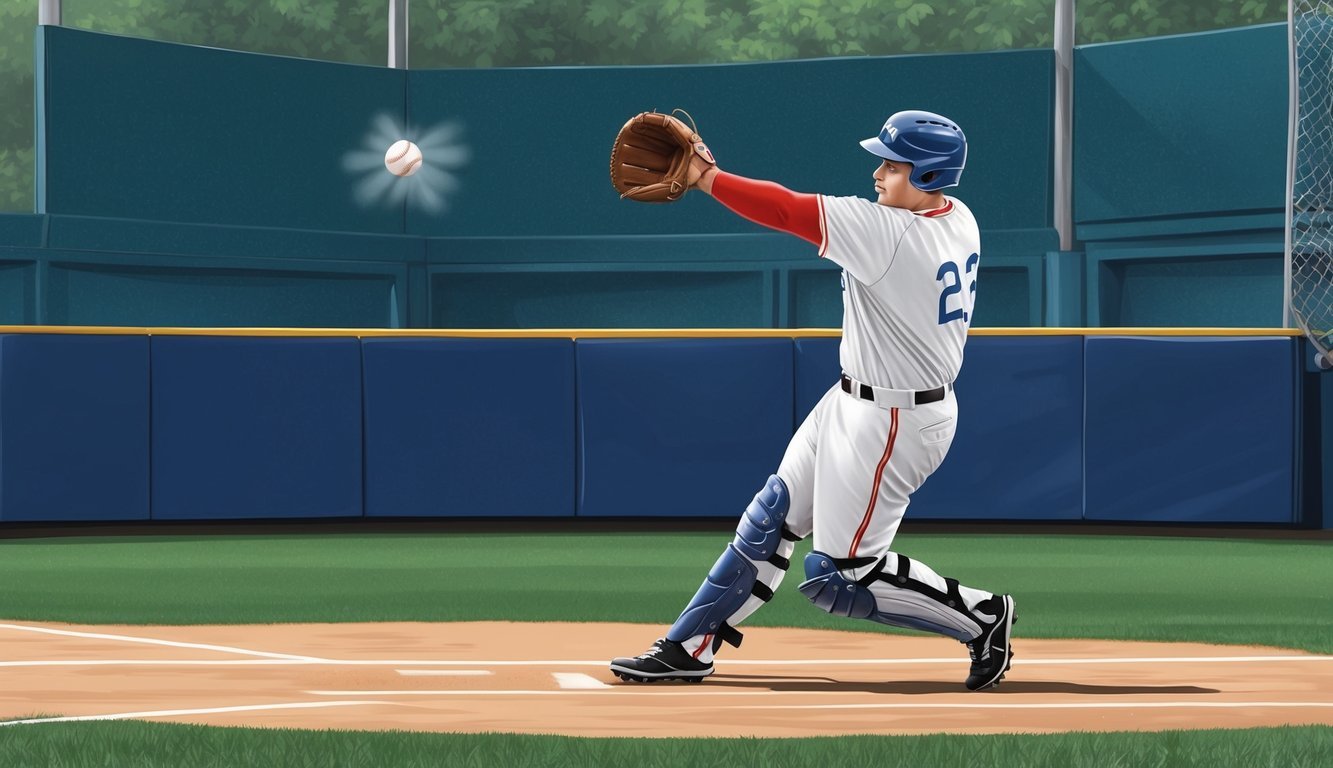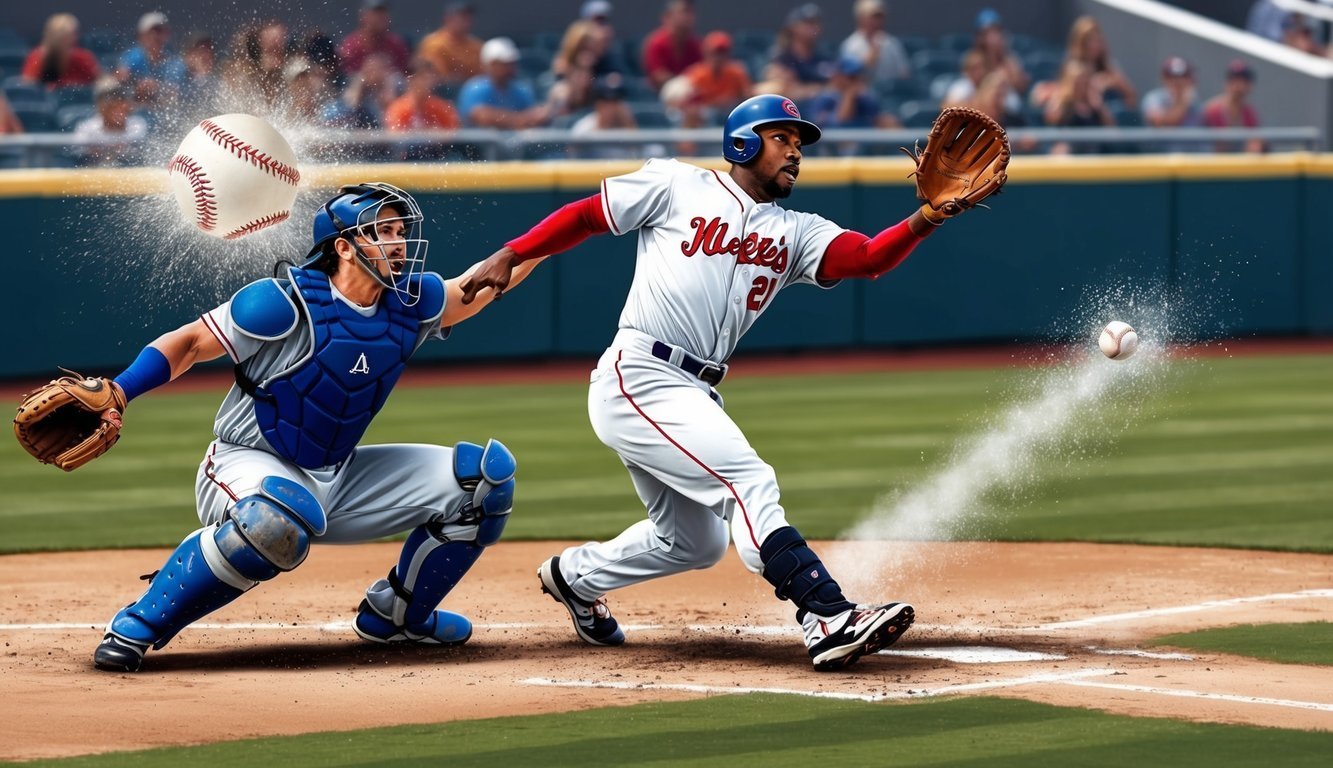A wild pitch can be a game-changing moment in baseball.
It’s that errant throw that sails past the catcher, allowing runners to advance and sometimes even score.
Wild pitches occur when a pitcher throws a ball too high, low, or wide for the catcher to control.
They can potentially turn the tide of a game in an instant.
Baseball fans know the excitement and tension that builds when a pitcher struggles with control.
A wild pitch can happen to even the most skilled hurlers, adding an element of unpredictability to the sport.
From Little League to the Major Leagues, players and coaches work tirelessly to minimize these costly mistakes.
The impact of wild pitches extends beyond just the scoreboard.
They can shake a pitcher’s confidence, energize the opposing team, and keep spectators on the edge of their seats.
Whether you’re a casual observer or a die-hard fan, understanding the role of wild pitches adds another layer of appreciation for the intricacies of America’s pastime.
Understanding the Wild Pitch
Wild pitches can dramatically shift the momentum of a baseball game.
They often result in runners advancing and sometimes even scoring crucial runs.
Definition and Rules
A wild pitch occurs when a pitcher throws a ball so erratically that the catcher can’t control it with ordinary effort.
This allows baserunners to advance.
The official scorer charges the pitcher with a wild pitch (WP) when this happens.
Wild pitches can be high, low, inside, or outside the strike zone.
They’re not always extreme – even slightly off-target pitches can become wild if the catcher can’t handle them.
Pitchers aren’t penalized statistically for wild pitches beyond the WP notation.
However, any runs that score as a result are earned runs against the pitcher’s record.
Wild Pitch or Passed Ball?
Distinguishing between a wild pitch and a passed ball can be tricky.
Both result in runners advancing, but they’re charged differently.
A wild pitch is the pitcher’s fault.
The throw is too difficult for the catcher to handle with normal effort.
A passed ball, on the other hand, is charged to the catcher.
It’s a pitch that should have been caught with ordinary effort.
The official scorer makes the final call on whether a play is ruled a wild pitch or passed ball.
This decision can sometimes be controversial, especially in close games.
Catchers work hard to prevent both wild pitches and passed balls.
Quick reflexes and good blocking techniques are essential skills for backstops to master.
The Impact on the Game
Wild pitches can dramatically alter the course of a baseball game.
They create opportunities for baserunners and put added pressure on pitchers and catchers in crucial moments.
Consequences for Baserunners
Wild pitches often allow runners to advance freely.
A runner on first might take second, while those on second or third can easily score.
This unexpected movement on the basepaths can quickly change the game’s momentum.
In tight games, a wild pitch can be the difference between winning and losing.
Imagine a one-run game in the ninth inning – a wild pitch could tie the score or even give the trailing team the lead.
Batters also benefit from wild pitches.
They might see better pitches to hit as the pitcher tries to regain control.
This can lead to more hits and runs scored.
Strategy and Tactics
Coaches and players must adjust their strategies when facing a pitcher prone to wild pitches.
Baserunners might take bigger leads, ready to capitalize on any errant throws.
Catchers may position themselves differently, anticipating potential wild pitches.
Pitchers who struggle with control might be pulled from the game earlier.
Managers have to weigh the risks of leaving them in against the potential for game-changing wild pitches.
Teams may also become more aggressive on the basepaths.
Stealing attempts could increase, putting extra pressure on the battery to execute perfectly.
In close games, every pitch becomes crucial.
Wild pitches can force pitchers to be extra cautious, potentially leading to more walks or hittable pitches.
Famous Wild Pitch Scenarios

Wild pitches have led to dramatic moments and unexpected outcomes in baseball history.
These errant throws can shift the course of a game or even a season in an instant.
Notable Games
In the 1941 All-Star Game, a wild pitch by Claude Passeau allowed Ted Williams to score the winning run.
The 1962 World Series saw a crucial wild pitch by Giants’ pitcher Jack Sanford in Game 7, helping the Yankees claim victory.
During the 2002 World Series, Giants’ closer Robb Nen threw a wild pitch in Game 6 that allowed the Angels to tie the score.
This moment swung the series momentum, and Anaheim went on to win it all.
In 2014, the Royals advanced to the ALCS when Athletics’ reliever Luke Gregerson uncorked a wild pitch in the AL Wild Card game, allowing the tying run to score.
Baseball Anecdotes
Rick Ankiel‘s story stands out in wild pitch lore.
In the 2000 NLDS, the young Cardinals pitcher threw five wild pitches in a single inning, derailing his promising pitching career.
He later reinvented himself as an outfielder.
Phil Niekro, known for his knuckleball, led the league in wild pitches seven times.
His floating pitch often baffled catchers as much as batters.
In one game, Niekro’s brother Joe caught him and used an oversized mitt to try and corral the unpredictable knucklers.
Nolan Ryan, despite his legendary status, holds the modern-era record for career wild pitches with 277.
His blazing fastball sometimes proved too hot for his catchers to handle.
Record-Holders and Statistics

Wild pitches have been a part of baseball since its inception, with some pitchers becoming notorious for their errant throws.
The MLB keeps detailed records of wild pitches, allowing us to identify the most prolific throwers throughout history.
Wild Pitch Leaders
Nolan Ryan tops the list of wild pitch leaders in MLB history.
The fireballing right-hander threw an astounding 277 wild pitches over his 27-year career.
Ryan led the league in wild pitches six times, showcasing both his longevity and his occasional lack of control.
Larry Cheney and Jack Morris also stand out, each leading their respective leagues in wild pitches six times.
Cheney’s most notable wild pitch performance came on Opening Day 1914, when he threw four wild pitches in a single game – a record that still stands today.
Career Records
Tony Mullane holds the all-time MLB record for career wild pitches with 343.
Pitching in the late 19th century, Mullane’s high total reflects the different playing conditions and equipment of the era.
Other notable career wild pitch leaders include:
- Walter Johnson – 206
- Bert Cunningham – 195
- Mark Baldwin – 183
- Red Ames – 180
Bill Gullickson and Mickey Welch also rank among the top wild pitch throwers in baseball history.
These statistics remind us that even the greatest pitchers sometimes struggle with control, adding an element of unpredictability to the game.
Technical Aspects of a Pitch

A pitcher’s technique, control, and pitch selection play crucial roles in avoiding wild pitches.
Understanding these elements helps players and fans appreciate the complexities of pitching in baseball.
Additionally, mastering various pitch types, including fastballs, curveballs, and especially the splitter, can significantly enhance a pitcher’s effectiveness on the mound.
Implementing splitter pitch techniques for baseball allows pitchers to create deceptive movements that can confuse batters, leading to more strikes and fewer wild pitches.
By honing these skills, pitchers not only improve their control but also elevate the overall quality of their game.
Pitch Types and Wild Pitches
Different pitch types carry varying risks of becoming wild pitches.
Fastballs, while speedy, are generally easier to control.
Curveballs and sliders, with their sharp breaks, can be trickier to keep in the strike zone.
Knuckleballs are notoriously unpredictable and prone to wild pitches.
Pitchers often use off-speed pitches to catch batters off guard.
However, these require precise execution.
A curveball that doesn’t break as intended can sail past the catcher.
Splitters and forkballs, aimed low in the zone, may bounce in the dirt if thrown incorrectly.
Weather conditions can affect pitch movement.
Wind and humidity can alter a ball’s trajectory, increasing the chance of wild pitches.
Pitcher’s Technique and Control
A pitcher’s mechanics directly impact their control.
Proper footwork on the mound establishes a solid foundation.
Consistent arm angles and release points help maintain accuracy across different pitch types.
Fatigue can lead to deteriorating technique.
As pitchers tire, their control may suffer, increasing the likelihood of wild pitches.
Managers often monitor pitch counts to prevent this.
Pitchers practice extensively to improve their command.
They work on:
- Repeating their delivery
- Hitting specific spots in the strike zone
- Adjusting to different game situations
Mental focus is equally important.
Pitchers must stay composed under pressure to avoid wild pitches in crucial moments.
Regular bullpen sessions allow pitchers to refine their skills and experiment with new pitches in a controlled environment.
This practice helps reduce wild pitches during games.
